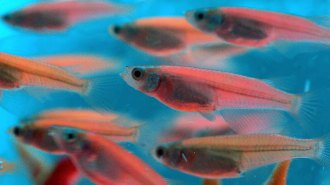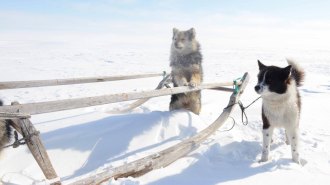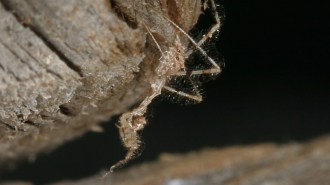Search Results for: Dogs
Skip to resultsCan’t find what you’re looking for? Visit our FAQ page.
4,004 results for: Dogs
-
 Science & Society
Science & SocietyHere are the Top 10 science anniversaries of 2022
Insulin to treat diabetes, the slide rule and the birthdays of Gregor Mendel and Louis Pasteur make the list.
-
 Life
Life‘Life as We Made It’ charts the past and future of genetic tinkering
A new book shatters illusions that human meddling with nature has only just begun.
-
 Archaeology
ArchaeologyDog DNA reveals ancient trade network connecting the Arctic to the outside world
People in Siberia were exchanging canines and probably other goods as early as 7,000 years ago with cultures as far off as Europe and the Near East.
By Freda Kreier -

-
 Animals
AnimalsAssassin bugs tap spiders to distract them before a lethal strike
Some assassin bugs stroke their antennae on spiders when within striking distance, possibly imitating touches that spiders experience near their kin.
By Jake Buehler -
 Paleontology
PaleontologyFossil tracks may reveal an ancient elephant nursery
Fossilized footprints at a site in Spain include those of an extinct elephant’s newborns, suggesting the animals may have used the area as a nursery.
By Sid Perkins -
 Life
LifeScientists have a new word for birds stealing animal hair
Dozens of YouTube videos show birds stealing hair from dogs, cats, humans, raccoons and even a porcupine — a behavior rarely documented by scientists.
-
 Physics
PhysicsBlack holes born with magnetic fields quickly shed them
New computer simulations show one way that black holes might discard their magnetic fields.
-
 Animals
AnimalsWould dogs return the favor if you gave them treats? It’s complicated
An experiment in which dogs did not reciprocate food giving with humans may reveal something about the dogs, or about how science is done.
By Betsy Mason -
 Animals
AnimalsDogs tune into people in ways even human-raised wolves don’t
Puppies outpace wolf pups at engaging with humans, even with less exposure to people, supporting the idea that domestication has wired dogs’ brains.
-
 Psychology
PsychologyPsychology has struggled for a century to make sense of the mind
Research into what makes us tick has been messy and contentious, but has led to intriguing insights.
By Bruce Bower -
 Space
SpaceVera Rubin’s work on dark matter led to a paradigm shift in cosmology
‘Bright Galaxies, Dark Matter, and Beyond’ tells the story of how astronomer Vera Rubin provided key evidence for the existence of dark matter.